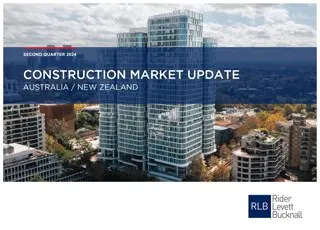According to the Rider Levett Bucknall (RLB) 2nd Quarter 2024 Oceania Report, the New Zealand construction sector output is one of dampened demand but long-term potential.
Economic climate and construction activity
In any economy, the construction sector is intricately linked to the broader economic climate. New Zealand’s recent economic slowdown, marked by a technical recession in late 2023, has cast a shadow on construction activity. Higher interest rates, implemented to combat inflation, are achieving their intended outcome – dampening demand. This has led businesses to adopt a more cautious approach to investment, particularly considering uncertainties surrounding the new government’s spending plans and potential cutbacks in the public sector.
Regional resilience and growth
Despite the national slowdown, there are pockets of resilience within the construction sector. Auckland, the country’s largest city, continues to hold a dominant position, accounting for approximately 41% of nationwide construction activity. This leadership role can be attributed to the city’s strong population growth, fuelled by continued immigration. However, even Auckland has witnessed a recent plateau in activity, suggesting a potential shift in the market.
Looking beyond Auckland, Canterbury has experienced a positive trend, with its share of national construction activity increasing since early 2022. This growth suggests a potential diversification in the sector, with regional markets taking on a more prominent role.
Regional variations in non-residential consents
A closer examination reveals regional variations in non-residential consent issuance, a key indicator of future construction activity. While Waikato has seen a decline in non-residential consents over the past year, regions like Bay of Plenty and Otago have registered robust growth. In Bay of Plenty, this growth reflects broad-based demand, encompassing healthcare facilities and office buildings. Similarly, Otago’s increase in non-residential consents is driven by healthcare facilities and accommodation buildings. The anticipated recovery in international tourism is expected to further bolster demand for accommodation construction in Otago, presenting a specific opportunity for targeted investment.
Infrastructure projects: A stabilising force
A bright spot in the current landscape is the robust pipeline of infrastructure projects, valued at nearly $108.5 billion. This significant investment provides much-needed stability for the construction sector. The recent severe weather events in the North Island have further contributed to this pipeline, with reconstruction efforts requiring substantial investment. The infrastructure pipeline is dominated by transport projects, with a total value exceeding $50.8 billion. Additionally, water infrastructure projects represent a significant portion with a value of $19.9 billion. The coming years will see substantial investment in these areas, ensuring continued activity for construction companies specialising in infrastructure development.
Focus on social infrastructure
In the near term, the focus of the social sector is expected to be community facilities and housing projects. This focus on social infrastructure aligns with the government’s potential priorities, and construction firms with expertise in these areas may see increased opportunities.
Construction cost inflation and market balance
Construction cost inflation, which has been a concern in recent years, is moderating. This shift is largely due to easing capacity pressures within the sector. Building firms report a decline in labour shortages, suggesting a more balanced market. Furthermore, the dampening effect of weak construction demand is expected to further moderate pricing pressures. This trend towards cost stabilisation presents a potentially positive development for both construction companies and project owners.
Long-term outlook
Although the current economic climate presents certain challenges for the construction sector, the long-term outlook remains positive. The underlying driver of population growth through immigration continues to be a fundamental strength. This sustained population expansion will necessitate ongoing construction activity to meet the housing and infrastructure needs of a growing population. The substantial pipeline of infrastructure projects further bolsters the long-term outlook. These government-led initiatives will ensure continued opportunities for construction companies specialising in infrastructure development. As economic conditions stabilise and business confidence recovers, the construction sector is well-positioned for renewed growth.
RLB tender price index annual % uplifts as at Q2 2024
| New Zealand | 2023 | 2024 f | 2025 f | 2026 f | 2027 f | 2028 f |
|---|---|---|---|---|---|---|
| Auckland | 5.5 | 2.0 | 2.0 | 3.5 | 4.0 | 4.0 |
| Christchurch | 5.0 | 2.5 | 2.0 | 3.0 | 3.0 | 3.0 |
| Wellington | 5.0 | 4.0 | 3.0 | 3.0 | 3.0 | 2.5 |
FURTHER INFORMATION:



